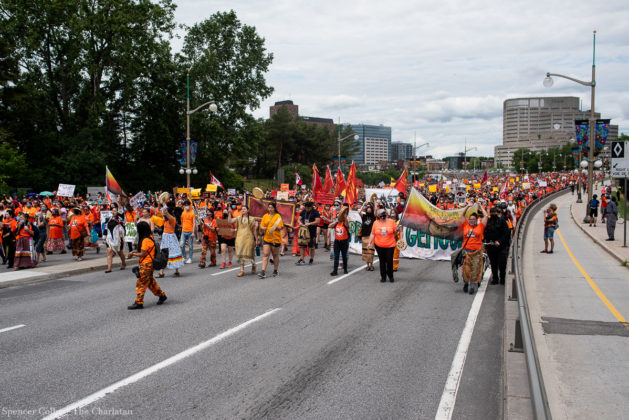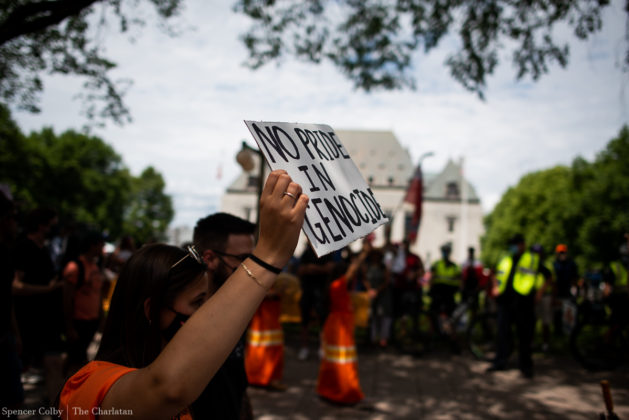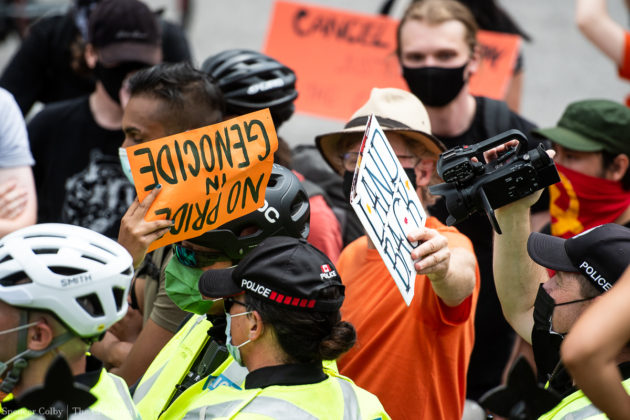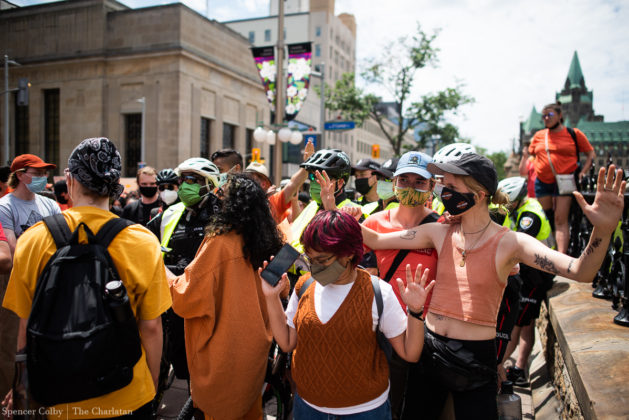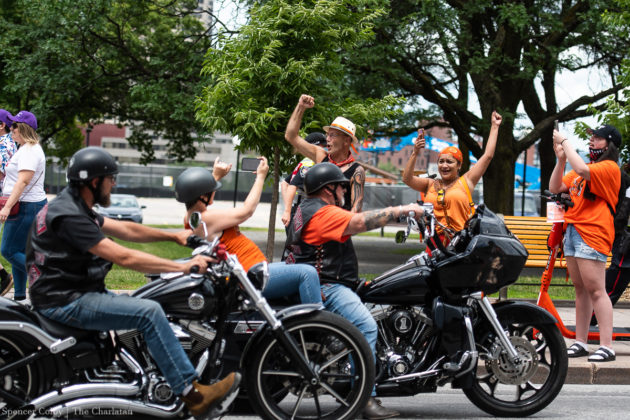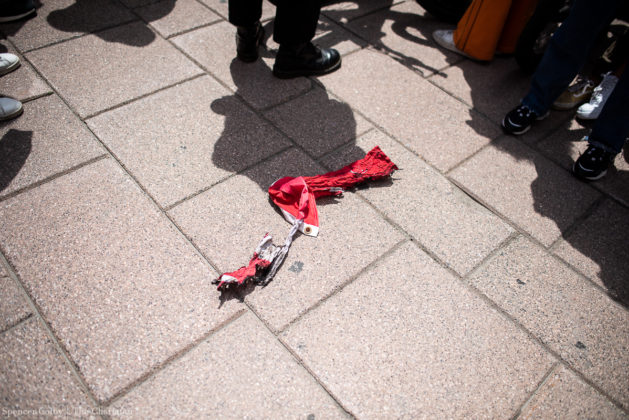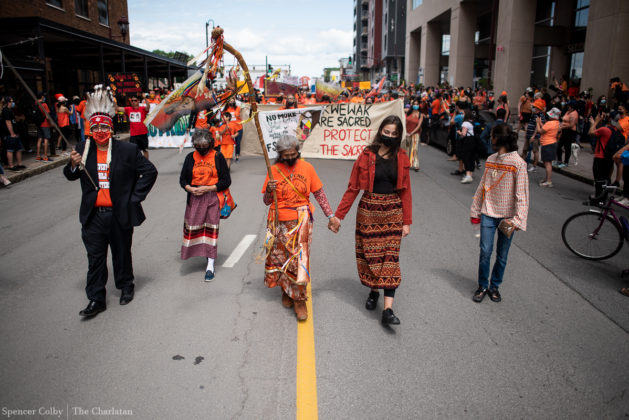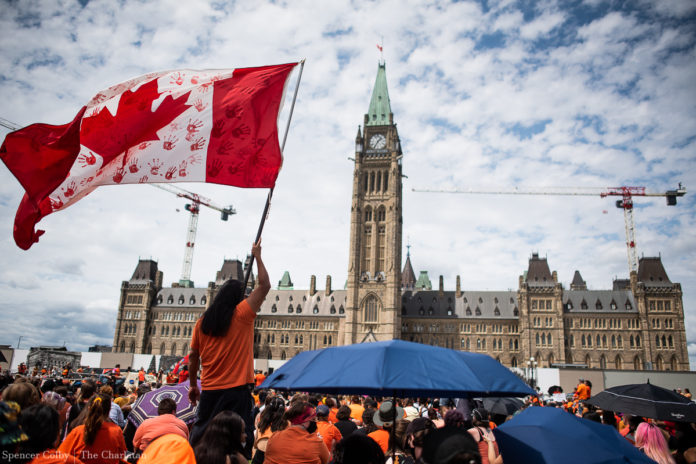
WARNING: This article contains potentially distressing subjects such as residential schools and resulting deaths. Those seeking emotional support and crisis referral services can call the 24-hour National Indian Residential School Crisis Line: 1-866-925-4419.
Over a thousand people marched on Thursday to protest Canada’s treatment of Indigenous people and the country’s history of residential schools while others celebrated Canada Day.
The march began at the Indigenous Services Canada building in Gatineau, Que. and ended at Parliament Hill. Most protesters wore orange: a colour that was adopted to commemorate the lives lost to residential schools.
Several of the chants repeated throughout the march were “shame on Canada,” “no pride in genocide” and “bring our children home,” referring to the newly-uncovered unmarked burial sites found at former residential schools across Canada.
Two-hundred and fifteen bodies were found at the site of Kamloops Indian Residential School, 78 at Brandon Indian Residential School, 751 at Marieval Indian Residential School and 182 at Kootenay Indian Residential School. Several other sites of former residential schools have ongoing investigations to uncover more unmarked burial sites.
“Given the recent discovery of the remains of over 1,000 of our children and youth and news of ongoing injustices that all Indigenous people have faced and continue to face today, what is there to celebrate? We should use Canada Day every year as a day to mourn and remember Indigenous peoples,” said Elmer St. Pierre, national chief of the Congress of Aboriginal Peoples in a press release prior to the event.
Once at Parliament Hill, several speakers addressed the crowd during the afternoon, including chiefs and Elders from the Mohawk, Ojibwe, Inuit and Guatemala Mayan nations, as well as Indigenous youth and residential school survivors.
The protest emphasized not just the historical crimes committed against Indigenous people, but also how they are affected by contemporary issues.
For Sana Touchachiche, who attended the protest with her son, the effects of residential schools on her family are felt very strongly.
“My baby is five years old and that’s the age that my father was when he was taken to a residential school,” said Touchachiche.
Other contemporary issues discussed throughout the event included missing and murdered Indigenous women, a lack of access to clean water on First Nations’ reserves and development projects built on Indigenous land without consent or consultation with relevant nations.
Parliament Hill and the entirety of Ottawa itself is built on land that was never surrendered or ceded in any agreement between the Algonquin Anishinaabe people and settlers.
Meanwhile, development projects like the 2016 Zibi building project at the Chaudière Falls were approved by Ottawa and Gatineau City Council despite facing strong pushback from Indigenous groups.
“If Canada is true to its reconciliation, it is with nations. It is not with corporations,” said Claudette Commanda, Algonquin Anishinaabe Elder and Indigenous rights activist, during her speech to the crowd. “We are the nation.”
Commanda is one of the leaders of the opposition to the Zibi project, as the development is being built on top of land that is sacred to the Anishinaabe people. Her late brother, Elder William Commanda, made his own proposal for a cultural centre on the island which would honour the land but was rejected in favour of the Windmill Development Group.
In addition to speeches, there was a prayer of thanks, live music and jingle dress dancers.
As the protest went on, several people from a nearby anti-mask protest tried to enter but were kept out by police. “Cancel Canada Day” protestors approached the anti-mask protesters and played drums to drown out the sound of heckling. The anti-mask protestors did not interrupt the event.
For Cass Nanticoke, a fourth-year film student at Carleton University and member of the Cayuga Nation, the protest was a meaningful way to reconnect with a community that she hadn’t been able to see because of the pandemic.
“As soon as I got down there, it felt so warm,” said Nanticoke. “It was a raw day, but I felt very positive, I felt very loved … There were so many people there and everyone was very open.”
Featured image by Spencer Colby.


